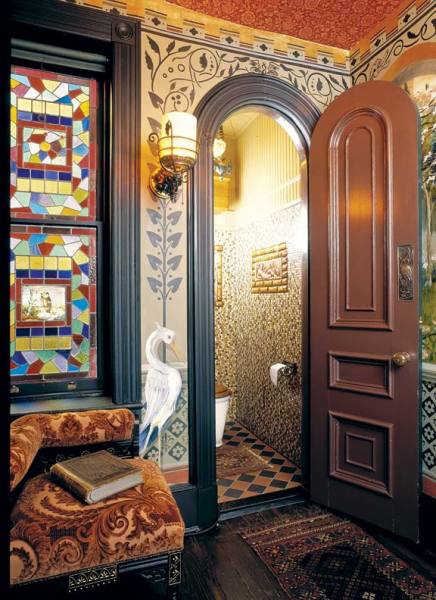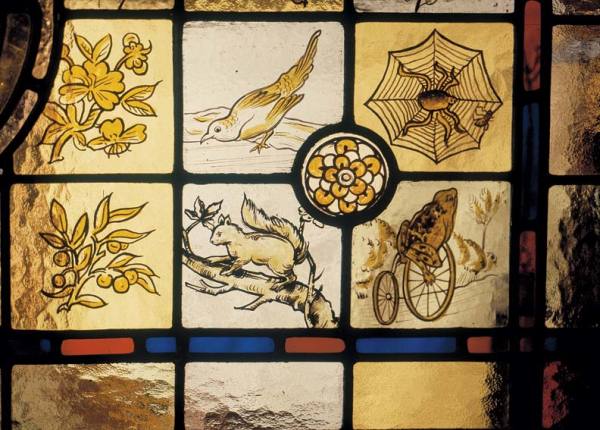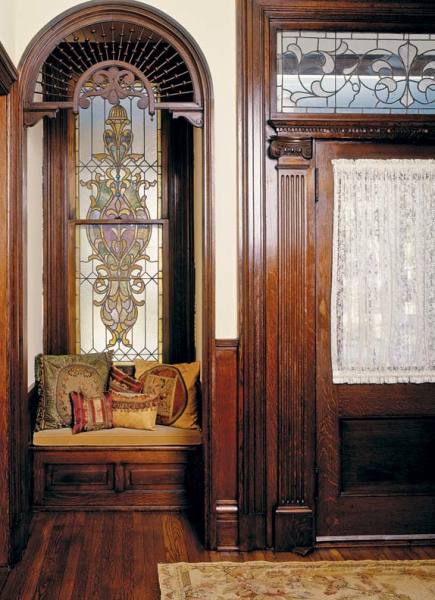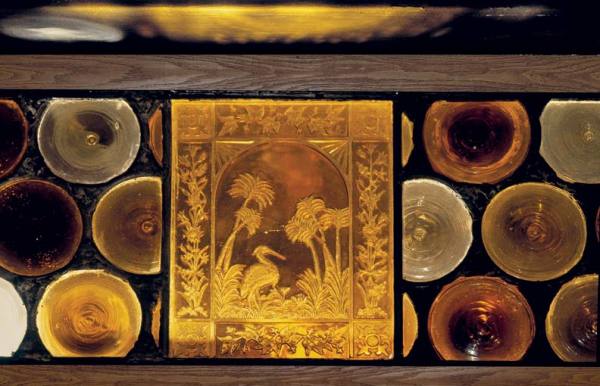Windows layered in color add ambience—and privacy—to a reading nook.
Leaded and colored glass doors built into a buffet, sparkling glass sidelights flanking a front door, richly hued panels of glass filtering light as it streams through a window transom—stained glass was a favorite accent throughout homes built in the 19th and early 20th centuries.
It added color and appeal, changing the quality of the interior light and lending another dimension to the room’s design. Stained glass was practical, too, performing many functions, from obscuring an unattractive outdoor feature to hiding the contents of an interior cabinet.
Many people shy away from buying antique stained glass due to concerns about whether it will fit an existing opening. However, if a window doesn’t fit exactly (and most don’t), you can always add or subtract glass to make it fit the frame. Curving or buckling glass also shouldn’t be a deal-breaker; the window may still be strong enough for many more years of enjoyment.
Try the finger drumming test: If you drum on the glass with your fingers and don’t hear a rattle, then the lead is still tight and the window secure. If panes do rattle, it means the putty has dried and is causing sections of glass to loosen in their lead cames (channels); they will need to be stabilized. But even this doesn’t need to be complicated. Stained glass windows, after all, are just glass and a little lead.
Simple Fixes
A fanciful painted glass window bears themes from nature.
For simple repairs, try taking a little putty, darkening it with lamp black, and pushing it into loose areas with your fingers or a blunt piece of wood. Let the putty dry for a few days, then trim off the excess with a putty knife, and your window will be as good as new. (For a step-by-step tutorial on how to do this, see here.) You also can try mixing the putty with linseed oil, a time-honored method that makes it easier to brush onto the window. Wipe off the excess with a newspaper, and your window will be stiffer and more airtight.
Stained glass doesn’t have to be perfect to use. A crack in the glass is much like the nicks and dents on old furniture—part of its charm and patina. Unless the glass is ready to fall out, a crack is best left in place, and often can be made more secure by gluing with clear epoxy cement.
If you have a sagging window that can be easily removed from its sash, brace it carefully against a piece of plywood or stiff cardboard and lay it on a flat surface for several days; the sagging will right itself. Be careful when handling old glass out of its sash—it’s a lot like handling a large pancake, and requires dexterity, patience, and a steady set of hands.
The stained glass window and transom in this Victorian house add beauty and play with streaming light.
Maintenance Tips
- Don’t expose the lead to the elements, as it will eventually leak as the putty weakens. Exterior storm sashes are helpful to protect your windows. I prefer interior storms, but it’s a tradeoff. Interior storms can help insulate and stabilize, but they don’t protect exterior elements—however, they also don’t change the home’s exterior profile.
- Clean with a simple solution of mild kitchen soap followed by a glass cleaner like Windex. Be sure to dry with a lint-free towel; many favor newspaper.
- If the window is in a bathroom or area where moisture causes the solder lines to become chalky (known as “foxing”), very fine steel wool will remove the chalkiness and return the solder lines to their original patina.
- Stops on glass doors are imperative to prevent breakage from a strong wind or a rambunctious child. And for those living in earthquake country, skylights should be buffered by a protective surface, such as ¼”-thick Plexiglass, that supports the window and helps prevent it from falling to the floor.
Old and New
Adding rondels around this etched stork pane created a larger window with an aged patina.
Good old glass can be expensive and hard to find, especially when you need several matching windows or desire a particular pattern, style, or color. While new stained glass may not have the patina and character of the old, it is readily available and can be custom-fit to a particular space and palette. New glass also doesn’t have the maintenance and repair concerns of older glass.
I’ve found that a combination of old and new glass frequently works the best. When I discovered an unusual pressed-glass panel depicting a stork, I knew I had to find a place for it. But the antique window was only half as large as the sash I had in mind for it—a transom above an interior door. So I had a custom wooden sash built that incorporated the vintage stork panel in its center and then filled the surrounding frame with new rondels of amber-colored glass, making sure that the leading around the rondels was thick and irregular to give the window age and character.
For another project, I had my heart set on a round window for a conservatory I’m adding to the back of the house. So I had a round window frame built, then removed a handsome Aesthetic Movement square window from an upper gable (where only the next-door neighbors could appreciate it) and added salvaged, hand-painted squares in a random pattern around it to fill in the rest of the curved frame. It’s hard to tell the window wasn’t entirely original.
Online exclusive: Need to repair a vintage stained glass window? See our step-by-step tutorial.







